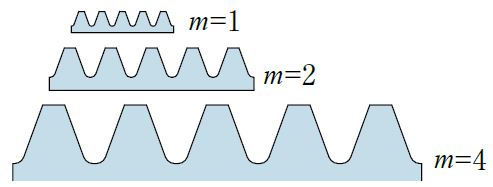What is tooth size?
ISO (International Organization for Standardization) specifies the use of the module as the unit of measurement for gear tooth size, and metric gears that use the module as the unit of tooth size are actually used in many countries around the world.
The formula for calculating the module (m) is m = d / z, where d is the pitch circle diameter and z is the number of teeth.
When tooth size is expressed in terms of module, the larger the module number, the larger the tooth size.
For convenience, the module is the pitch (p = πd / z) divided by π. Multiplying the module by π gives the actual size of the module in mm, for example, 2π = approximately 6.283 mm for module 2.
On the other hand, in some countries such as the United States, where the inch is used as a unit of dimension, DP (diametral pitch) is often used as a unit of tooth size.
Unlike the case of module, when tooth size is expressed in DP, the larger the DP number, the smaller the tooth size.
Gears that use DP as the unit of tooth size are called imperial gears (DP gears).
The following is a conversion formula between module and DP.
Module (m) = 25.4 / DP

Size comparison of each module in gear rack (not full-size)
相关链接 - 齿的大小


